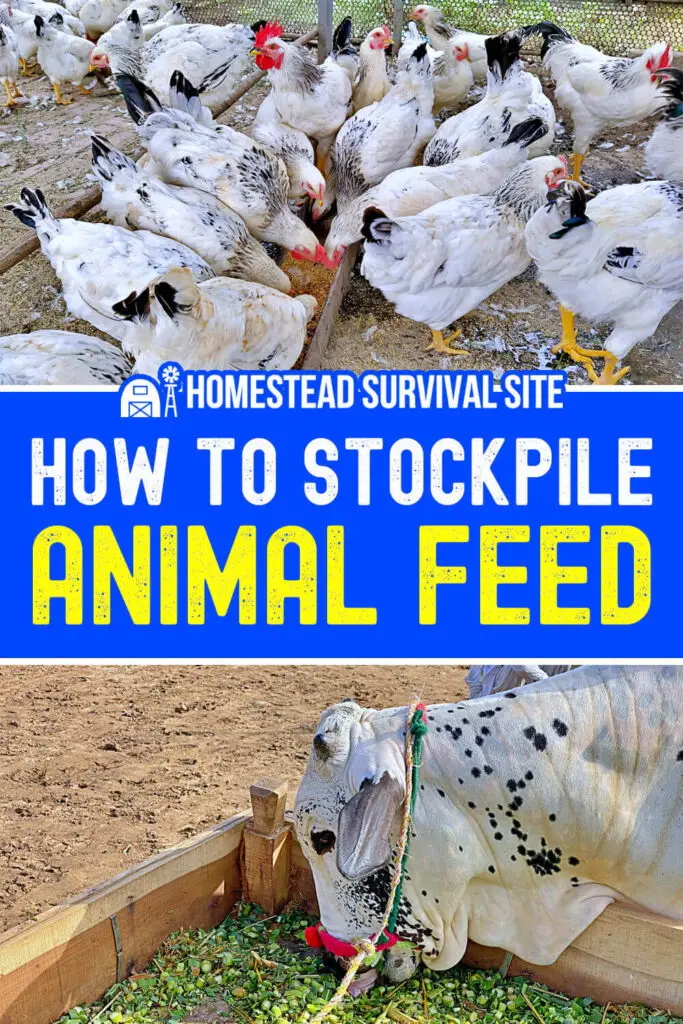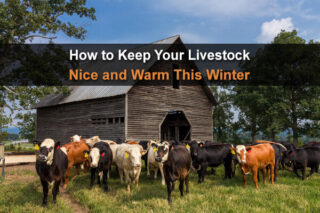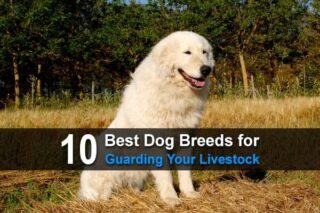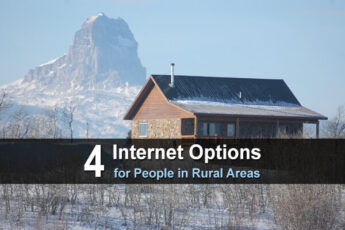Estimated reading time: 8 minutes
Natural disasters, extreme weather events, supply chain uncertainty, inflation, civil unrest, and global conflict. With so much out of our control, one of the ways we can gain some peace of mind during these uncertain times is by building and maintaining an emergency food pantry.
Of course, you want to focus first on the needs of two-legged members of your family. However, it’s also important to consider your four-legged friends as you prepare for an emergency. This article offers tips for stockpiling food and other disaster preparations for your pets and livestock.
Want to save this post for later? Click Here to Pin It On Pinterest!
How much food do you need to store?
Many emergency sites recommend having a three-day food and water supply for each person and animal. That may be a good place to start, but, unfortunately, most disaster recovery times last far longer than three days.
You can start small but aim to build up to a three-month supply. Begin by keeping track of how much food your animals eat. It’s trickier than you might think since food consumption—especially livestock food consumption—can vary according to the time of year, age of the animal, and other circumstances.
Go through your receipts for the past year in order to get an estimate of how much animal feed you need per month. When in doubt, round up the quantities.
How much to feed to store per animal depends on the weight of the animal and what you have available for the animals to forage at any one time of year.
Ruminant animals (including cattle, goats, and sheep) generally require 2.5% of their body weight in dry feed forage per day. A rough estimate for pigs is 4% of their body weight daily.
The University of Kentucky Agriculture Extension Office has a chart that offers feed quantities based on weight for chickens.
The site suggests that if your chickens do not have free-range access, they will require one-fourth to one-third pound of feed per bird per day. Here’s more on feeding chickens.
To make things even more complicated, animals tend to eat more in cold weather to maintain body heat and also when they are stressed. (We do too!)
How to store emergency animal feed
The enemies of your emergency animal food supply are the same as the ones that can affect your human food supply. The primary ones are heat, sunlight, moisture, and pests.
According to feed storage guidelines from the University of Washington, bulk feed should be stored in areas where the temperature does not exceed 70℉ or 50% humidity. Feed bags should be stored off the floor and at least six inches away from the wall. Feed should be stored in a covered area with adequate ventilation.
The size and material of the containers you use will depend on the type of feed and the size and weight of its particles. Be sure to consider the weight of the feed itself you plan to move the containers around. (Even though chicken feed is light, a trashcan-size container full of it is very heavy!)
You’ll want to follow the same rules you do for your own long-term food supply:
- Use airtight containers with tight-fitting lids.
- Keep food away from heat sources and sunlight.
- Use oxygen and moisture absorber packs.
- Keep containers off the ground whenever possible. You can use pallets or stacked bricks to elevate large bins.
- Follow your senses. If the feed smells or looks “off,” it probably is not safe for your animals.
Here are some container options:
Heavy-duty plastic totes. Check out the ones specially designed for animal feed that have angled lids to make scooping easier.
Metal trash cans. These are great for keeping out rodents, but be aware that the metal can rust when exposed to the elements. Make sure the trash can lids maintain a tight fit.
Old chest freezer. Instead of taking it to the dump, you can repurpose an old chest freezer to hold animal feed. It already is airtight and is made to keep food off the ground and safe from pests.
Food-grade plastic buckets. You can purchase or repurpose five-gallon buckets to hold your animal feed. Be sure t check for the food-grade symbol on the bottom of the bucket. You’ll need tight-fitting lids to keep food safe from the elements and pests.
Barrels and drums. Lidded food-safe barrels and drums are other options for long-term feed storage.
It’s worth repeating that you make sure any container you use for your animal feed is marked as food-grade and did not previously hold something toxic that could contaminate the feed and harm your animals.
How to determine the shelf life of animal feed
The shelf life of animal feed depends on how it is harvested, processed, packaged, and stored.
According to the University of Illinois Extension Service, whole grains and feed containing oilseeds (oats, flax, canola, and sunflower) have longer storage lives than processed grains.
Seasonal changes also come into play. For example, If barley (1.5% fat content) is dry rolled in the fall or winter, its storage life is around six months. However, if the barley is rolled in the summer, its shelf life can be cut in half.
With oats (3.5% fat) that are rolled in the fall, you can expect three to four months of storage. However, oats rolled in the summer may have only a brief three weeks of storage before the grain becomes moldy or rancid.
Here are some other factors that determine the shelf life of animal feed:
- Pelleted grains have increased storage times of up to six months because of the heating process they’ve had.
- Grain-free foods have a shorter shelf life than foods containing some grain. Grain-based feed contains natural antioxidants that can help prevent deterioration and conditions that cause the food to turn rancid.
- Livestock feed containing corn, sorghum, cottonseed, coconut, cassava, or sunflower may become contaminated with mycotoxin fungi over time.
- Adding minerals, vitamins, or medicines into feeds impacts storage time.
You may want to consider dehydrated and freeze-dried meats to help improve the taste and nutrition of stored animal rations, especially for your family’s pets.
Other safety considerations for animals
In addition to making sure your animals have food and water, you’ll need to consider their safety during an emergency. Have you thought about what will happen to your animals if you have to evacuate?
Many evacuation centers, shelters, or hotels do not allow family pets, let alone have accommodations for livestock. Here are some steps to take now – before a disaster happens.
Dogs, cats, and other household pets. Get your pet microchipped. Keep your phone number and other contact information up to date. It’s a good idea to include an emergency contact outside of your immediate area as well in case you are unreachable.
Have pet carriers/crates in a convenient location and assemble a “go bag” for each indoor pet. Here are some items to include:
- A three-day supply of food in an airtight, waterproof container.
- A water bowl and supply of water.
- Any medicine your pet requires in a waterproof container.
- Backup leash, collar, and ID tag.
- Copies pet’s registration and vaccine information in a waterproof container.
- Sanitation needs. Poop bags, kitty litter, and litter pan (a disposable aluminum roasting pan can work).
- Familiar everyday items. Include toys, treats, or bedding to help reduce your pet’s stress for your pet.
Large animals and livestock. Especially if you live in an area that is often affected by severe weather events or wildfires, research evacuation options in advance and create a plan.
Places that might offer shelter for large animals in your area include fairgrounds, racetracks, veterinary colleges, livestock corrals, pastures, showgrounds, equestrian centers, and auction facilities.
Here are other steps to take:
- Have identification documents (printed and available online) for all animals.
- Consider primary and secondary evacuation routes.
- Establish a network of people who can help you transport your animals.
- Plan how to access trailers or vehicles needed for transportation.
- Stay on top of current conditions, evacuating animals early if possible.
- Keep a list of the species, number, and location of all your animals near your “go bags” and other emergency supplies. Note your animals’ favorite hiding spots to save time when time is precious.
If you do not have the time or the means to evacuate your large animals or livestock in an emergency, the American Veterinary Medical Association has some advice.
- Move animals to the safest place on your property based on the current threat (such as high ground if flooding is imminent).
- Provide them with access to food and water, keeping in mind that automated systems may not work.
- Secure or remove objects that could turn into flying hazards.
It’s also a good idea to contact your state department of agriculture and county extension service to find out what they recommend or what services they have in place in the event of an emergency evacuation. You’ll find more tips for emergency care for specific types of livestock here.
We found these additional resources to check out to help you plan now for the health and safety of your animals during an emergency.
- Livestock Disaster Preparedness from the Humane Society
- Disaster Planning with Animals from the USDA
- Disaster Preparedness from the ASPCA
- Pet Disaster Preparedness from the Red Cross
- Pet Preparedness from the Humane Society
Like this post? Don't Forget to Pin It On Pinterest!
You May Also Like:











